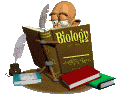
Evolution

Chapter Objectives
At the end of this unit students
will be able to
1. compare the Primordial Soup and Bubble Models for the origin of biochemicals.
2. describe how cellular organization might have begun.
3. recognize the importance of hereditary mechanisms for the development
of life.
4. distinguish between two major groups of prokaryotes, the Archaebacteria
and the Eubacteria.
5. describe the evolution of eukaryotes.
6. relate the development of ozone to the adaptation of life on land.
7. describe how multicellular organisms came to live on land.
8. summarize the main points of Darwin’s theory of evolution by
natural selection.
9. describe the process of species formation.
10. compare and contrast gradualism and punctuated equilibrium models
of evolution.
Chapter Terms
| Origin of Life | Evolution |
| radiometric dating radioisotope half-life microsphere fossil Cyanobacteria Eubacteria Archaebacteria endosymbiosis Protista extinction mass extinction mycorrhizae mutualism arthropod vertebrate continental drift |
population natural selection adaptation reproductive isolation gradualism punctuated equilibrium paleontologist vestigial structure homologous structure analogous structure divergence convergence speciation |
Animated
Graphics Courtesy of

Jo's World